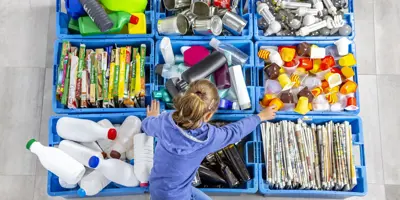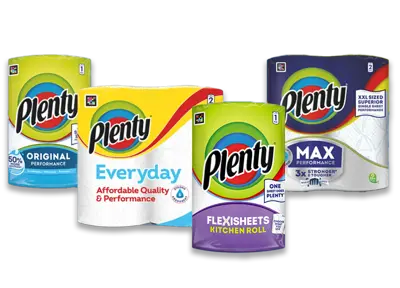1 person found this helpful
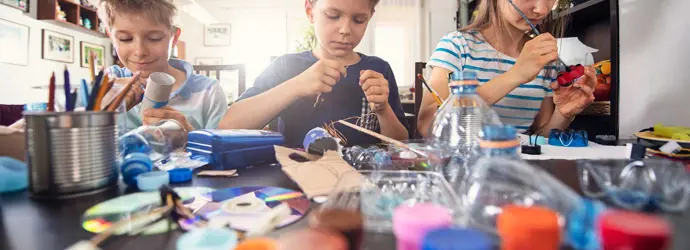
It's bath-time. There are suds up the wall, dripping from the ceiling and seeping into gaps between tiles you where you just know they’ll make their grout-y little homes in for the foreseeable. But hey? At least the little ones had fun right, right?! Whether it’s using less water or throwing less food away, there are straightforward ways to reduce food waste or limit the amount of waste produced, to help make a difference. When thinking about how to reduce household waste, try using these easy tips in your everyday life and you’ll be well on the way to reducing waste at home.
This is a comprehensive list of methods of how to reduce waste of food, reduce energy waste and reduce water waste, so it’s important to remember: only do what you can! The issue of climate change and environmental responsibility is a big one; it can be easy to feel overwhelmed by it all. By reducing waste at home, be happy in the knowledge that you’re doing your bit. It’s a good thing – so you should feel good about yourself!
Tip
When shopping, look for products from companies that practice sustainability, like Plenty. For example, with the use of recycled plastics, we’ve reduced the carbon footprint of our packaging. One of our key commitments is to reduce our greenhouse gas emissions by 25% by 2030 from a 2016 base-year.
How to reduce waste from everyday essentials
In 2018, the UK alone generated 222.2 million tonnes of total waste. That’s a lot of overflowing kitchen bin towers! This is a huge amount, particularly when it’s easy to avoid some of this waste.1
From using every drop of shower gel before the empty bottle is left weeks to circle the bathtub drain before it's recycled, to sewing the popped button back into your waistband after finding room for that second dessert (it’s a different compartment, we know!), let’s begin with a quick look at how to reduce household waste:
- Learn how to repair items rather than buying new ones. Commonly used household products are often easy to fix and there’s a wealth of info about fixing stuff online.
- Teach the kids how to reduce waste. Teaching the little ones to be mindful in their consumption is going to pay dividends in the long run.
- Be creative with used packaging and cardboard tubes. Whether it’s turning empty cardboard tubes into toy aeroplanes, or cardboard princess castles, there are plenty of options to try.
- Use kitchen paper. Use a strong and absorbent kitchen paper – like Plenty - to remove dirt and grease and to stop plastic sponges from going to landfill; cover food before serving with kitchen paper instead of plastic wrapping. Adding a sheet to your fridge drawer can also help soak up excess moisture for keeping salad leaves crisp for longer. No one likes a soggy bottom drawer – especially when it’s growing fur!
- Finish beauty products and toiletries. Squeeze out every last drop before you open a new one.
- Use canvas shopping bags. Rather than picking up a plastic one every time you hit the shops.
- Reuse containers! Bought yourself a tasty curry for date night that you know you’ll be reminded of forevermore, once your other half inevitably slops it down your cream sofa? We’ve all been there. And while a curry-smeared sofa is more of a reminder of your love than you’ll ever need, your curry’s container can be, too! Whether it’s a glass jar from a delicious dessert shared, or a plastic pot, reuse those containers for home-made jams, leftover food, or just the random odds and ends we all find leftover from meals with our loved ones.
Tip
The importance of reducing waste isn’t the most exciting subject for kids, but it’s a worthwhile lesson. Check out some of our plastic pollution facts for kids to find the right balance when educating your kids on sustainable initiatives. We’ve also got some great ideas on how to make recycling fun!
How to reduce wasted energy:
When it comes to finding out how to reduce waste at home, limiting the amount of water, gas, and electricity you use can make a huge difference. These forms of energy can also go hand in hand, as we use electricity to power water-using washing machines and dishwashers, and we use gas to heat water. Let’s dive deeper in to how to reduce wasted energy from water, electricity, and gas.
How to reduce water waste
Why is it important to reduce water waste? According to Waterwise (an independent, not-for-profit UK NGO), the UK could experience water shortages by 2050 if it doesn’t start to use water more efficiently.2
However, we can help make sure there’s enough water to go round by learning the facts and making simple changes. Here are some handy tips:
- Take short showers rather than deep baths. Did you know, a bath uses about 80 litres of water, compared to a short shower using just a third of that?3 Practice your singing or your award acceptance speech in the shower instead.
- Use the washing machine and dishwasher efficiently. Only wash clothes in the machine when you have a full load and wash them on a lower temperature setting. The same goes for your dishwasher.
- Use a water butt to collect rainwater for your garden. This will save on having to use a hose or sprinkler.
- Turn off the tap when you brush your teeth. You can also reduce the amount of water wasted by doing your washing up in a bowl rather than under a running tap. Wipe the inevitable toothpaste splatters off the mirror in one fell swoop at the end!
How to reduce energy waste – electricity and gas
Just like these simple efforts to reduce water waste, there are ways that electricity is wasted that we can easily avoid. Here are some simple ways to help reduce energy waste at home:
- Turn off appliances when not in use. Rather than leaving them on standby mode.
- Turn off lights when you’re not using them. Or turn them down low for some ambience.
- Look into investing in some energy-efficient appliances. This could be as simple as replacing the lightbulbs in your house with energy efficient options, or as big as investing in energy-efficient white goods, such as fridges and freezers.
- Improve your home’s insulation. Consider investing in cavity wall insulation and double-glazed windows. This can be a costly investment, but it could actually save you money in the long run!
That’s how to reduce wasted energy, now onto how to reduce waste of food.
How to reduce food waste
According to WRAP (a climate action NGO established in the UK in 2000), the UK alone throws away 6.6 million tonnes of household food waste a year, when around three-quarters of that could have been eaten.4
It’s clear that this is an area that’s important to focus on, and there are some simple things we can each do to help make a difference. Here are a number of steps you can take to help reduce waste of food:
- Always do a stock-check before shopping. This helps to avoid unnecessarily buying items you already have.
- Keep an eye on expiry dates. This means food won’t spoil and get wasted. Put items with the soonest use-by dates at the front of your fridge and cupboards, so you use them first.
- Make proper use of your freezer. Foods that go out of date fairly quickly can last for much longer at sub-zero temperatures.
- Use fruit and veg that’s going out of date in smoothies and soups. These are easy to freeze, so you can make use of fresh produce for longer. Just please, for the love of kitchen cabinets, make sure the lid is on before you start blitzing! (Beetroot-spattered décor could look cool, though, right?)
- Give leftovers a new lease of life. Learn the cooking fundamentals so you can be creative with leftovers.
- Use the best storage option. Read food labels so you know how to store groceries correctly.
There are few things more satisfying in life than cobbling together a tasty meal out of bits from the fridge that would’ve been destined for the bin. Have you ever cooked with or eaten everything from a food shop before, without wasting any of it? That’s a feeling you’ll chase forever.
We’ve written a guide which focuses solely on reducing kitchen and food waste – check it out!
If you do have food waste – compost it!
So, you’ve learned how to reduce food waste, but some waste is inevitable. It’s what you do with it that counts!
We’ve all been there – the skin of an onion, the thousands of tiny pieces of garlic peel, the used teabag sitting by the sink. It just feels weird to throw them away. So, don’t! These items – as well as many, many more – make absolutely fantastic composting materials.
Whether it’s a small compost bin in the kitchen, or a giant heap at the back of the garden, adding organic materials like vegetable peels, rotten fruit, egg shells and used tea bags to your compost can produce a nutrient-rich addition to the soil in your garden or planters. After all, food waste, when composted at home, potentially reduces food waste sat in a landfill.
Tip
Did you know that Plenty Original kitchen roll sheets are now certified compostable?* That’s right, they’re compostable sheets for compostable messes!
This waste can help your garden grow – and trust us, it’s actually quite satisfying! It’s important to only compost these Plenty kitchen roll sheets if they’ve been used on a compostable mess, though, so check out what can and can’t be composted before you go being a green-fingered eco-warrior!
New to the concept of composting? We’ve created a handy guide so you can learn more about the composting process and get going. Want to know more about Plenty’s compostable kitchen roll sheets? Check out the answers to your frequently asked questions.
There you have it, plenty of easy steps you can take to start making more of a difference. Spread the word about how to reduce waste at home so that you, your friends, and your family can all make positive changes.
*Plenty kitchen towels are certified as home and industrially compostable according to NF T 50-800 and EN14995.
Sources:
1 Department for Environment Food & Rural Affairs: UK Statistics on Waste
Related articles
Clean and green! 10 tips for eco-friendly cleaning
From baking soda and lemon cleaning methods to a surprising kitchen cupboard treatment for mould, read our sustainable cleaning products ideas for your home!
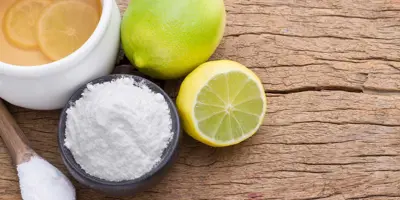
7 steps to create a DIY cardboard castle at home
Learn how to make a cardboard castle to fit their favourite interests. Find step-by-step cardboard castle DIY instructions and theme ideas here.

6 tips on how to save water at home
Learn how to save water at home. Find five easy ways to conserve water, so you can bring down your waste and make some clever savings in the process, here.

What does biodegradable mean and what is non-biodegradable?
Biodegradable and non-biodegradable? What do they mean?! Don’t fret, discover the definitions and biodegradable materials to become an eco-friendly pro!
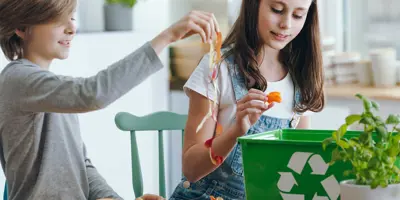
How to lead a sustainable lifestyle in 5 key ways
Learn how to live more sustainably with our tips on diet, methods of transport, energy consumption and product choices. Find sustainable living examples here.

How is plastic packaging recycled, and what does it get turned into?
How can plastic be recycled? Discover the steps that plastic goes through in the recycling process, and how much plastic is actually recycled, here.
